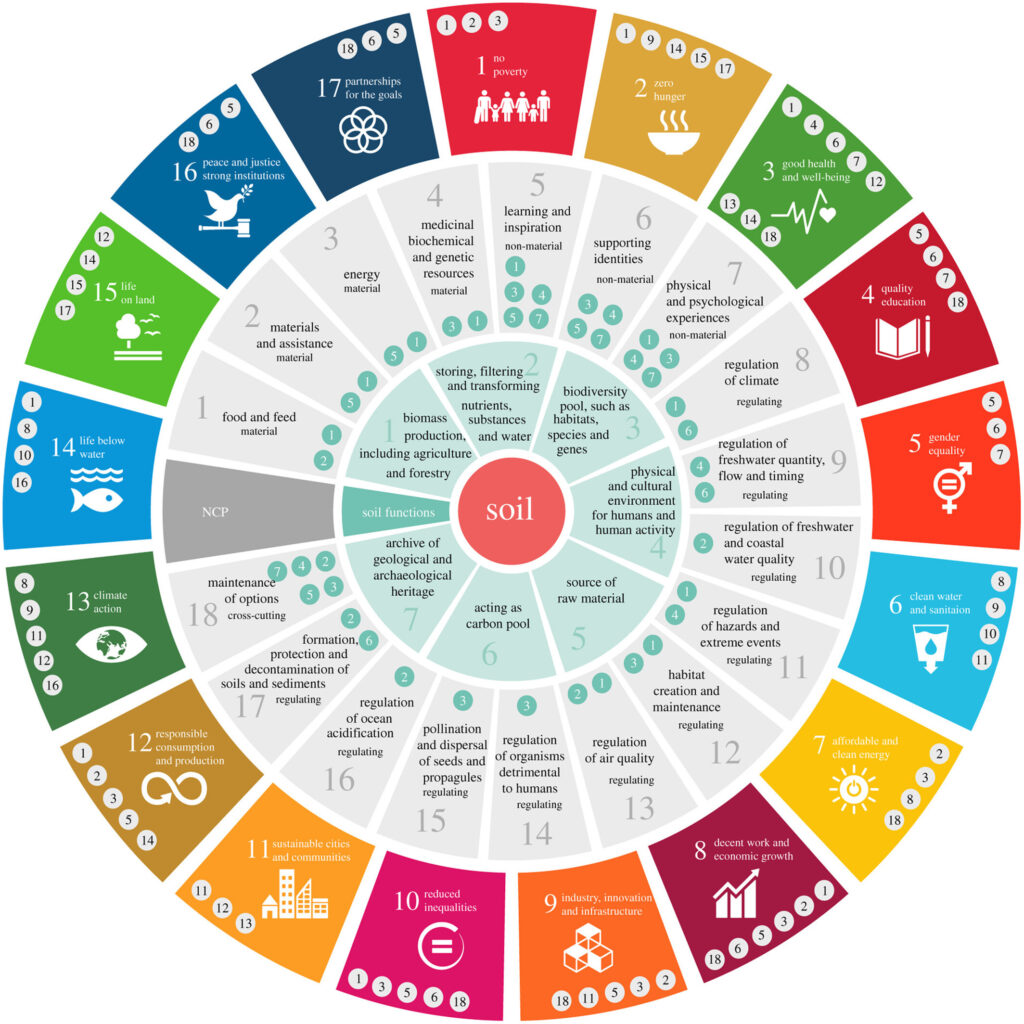Advancing nature-based solutions through enhanced soil health monitoring in the United Kingdom

This case study is an abridged version of the original text, which can be downloaded from the right-hand column. Please access the original text for more detail, research purposes, full references, or to quote text.
Introduction
The foundation of nature-based solutions (NbS) lies in the understanding that well-functioning ecosystems offer numerous essential services critical for human well-being, such as carbon sequestration, flood management, shoreline and slope stabilization, and provision of clean air and water, food, fuel and medicinal resources. Many of these services are underpinned by healthy soils, yet most of the world’s soils are degraded, and soil erosion is likely to increase up to 60% in the next 30 years.
NbS can play a key role in safeguarding and restoring our soils for future generations in many ways, such as through soil–water conservation methods in farming, peatland restoration and reforestation on erosion-prone slopes. Explicitly including soil health as an additional objective in many NbS projects would lead to a more integrated approach that considers both the above- and below-ground components of ecosystem functioning and services simultaneously.
This paper discusses the importance of integrating soil health within NbS planning and monitoring. It explores general principles derived from global research and their potential integration into UK policy and practice, particularly in light of developing agri-environment policies for soil health and the UK’s relatively advanced soil monitoring approaches.

Methodology
The paper follows a narrative approach, synthesizing evidence from peer-reviewed literature, government reports, policy documents and case studies on literature on the integration of soil health within NbS. Relevant studies were identified through targeted searches in databases such as Web of Science, Google Scholar, Scopus and Google using key terms like ‘soil health’, ‘soil quality’, ‘soil ecosystem services’ ‘soil functions’, ‘soil monitoring’, ‘sustainable land management’ ‘nature-based solutions’ ‘ecosystem services’, ‘sustainable development goals’ and ‘climate change mitigation/adaptation’. The review primarily focuses on research published from 2000 to 2023, with an emphasis on both global and UK-specific studies. The themes explored in this review, such as soil health monitoring, the role of soils in ecosystem services and the integration of soils within NbS, were identified both inductively from common trends in the literature and deductively, based on gaps in previous reviews recognized by the authors. This approach allowed for the exploration of key trends, challenges and opportunities, while also identifying gaps in the current knowledge base.
How soil health underpins Nbs
Healthy soils are a vital component of successful NbS, supporting a wide range of interdependent functions which underpin ecosystem service provision in both agricultural and semi-natural habitats, and are essential for the sustainable development of human societies. In addition, healthy soils contribute to the stability, productivity and sustainability of ecosystems by enhancing adaptation and resilience to environmental change. Healthy soils can play a key role in delivering the Sustainable Development Goals (SDGs), adopted by the United Nations in September 2015. All 17 SDGs can be directly or indirectly linked to soil (Figure 1), with the strongest links for alleviating poverty (SDG 1), ending hunger (SDG 2), improving health (SDG 3) among others.

Figure 1: Functions provided by soils (inner ring), the Nature’s Contributions to People (NCP) provided by soils underpinned by these functions (middle ring) and impacts on the SDGs through the NCP supported by soils (outer ring)
Soil health governs the health of entire landscapes, including indirect effects on aquatic habitats via regulation of erosion and water quality. As soil communities and processes are an important determinant of above-ground communities, ecological restoration and other types of NbS increasingly need to consider below-ground factors that will influence the establishment of semi-natural habitats. Despite the vital role of soils, between 60% and 70% of the soils across the EU are categorized as unhealthy due to unsustainable management practices, losses in soil organic carbon and threats to biodiversity. Therefore, it is important that maintaining soil health and its contribution to ecosystem functions is integrated into the design, implementation and monitoring of NbS and supporting policies.
Soil health monitoring: Challenges and opportunities
need to monitor soil health
A robust monitoring system is needed to ensure that soil health is maximized alongside the other benefits from NbS. This will allow us to assess progress in restoration efforts, identify the most effective actions for enhancing soil health and provide insights for developing new adaptation strategies in response to future change. Using soil health monitoring data can help design policies that focus efforts where they are most needed, for example by identifying target areas where soil degradation is occurring. More consistent monitoring of soil health could present many opportunities to enhance the effectiveness, scalability and impact of NbS on global environmental and sustainability goals. Monitoring can also help to identify and manage any trade-offs that occur between different goals such as food production, flood and erosion protection, carbon storage and biodiversity, ensuring that soil management actions support, rather than frustrate, broader NbS outcomes.
EXISTING ASSESSMENT TOOLS
Soil biodiversity and soil biological properties are considered essential metrics for understanding and assessing soil health. However, a review by Bünemann et al. (2018) found that the key metrics used to assess soil were mostly physical and chemical indicators, notably SOC, soil pH, bulk density, available phosphorus and water storage. Biological metrics such as soil respiration and earthworm abundance were mentioned less often, and absent in 40% of the publications and tools reviewed by Bünemann et al. (2018).
In the UK, the UK Centre for Ecology & Hydrology (UKCEH) chose a set of four key indicators to monitor soil health across the UK, including a benchmark for each across different landscape types. These were bulk density, SOC, pH and earthworm abundance, hence covering physical, chemical and biological aspects. Similar approaches in the UK include the Soil Health Scorecard and Soilmentor. While these tools are useful, relying on a limited set of indicators might not capture the full breadth of soil health and its multifunctionality, and may not fully account for the specific conditions or issues pertinent to different regions. Additionally, these indicators are based on measuring the top 15 cm only, and not the full soil profile. A more comprehensive and flexible set of soil health indicators, tailored to the specific contexts and goals of different regions and land uses, would likely be more effective in capturing the complexity of soil health and guide towards a more effective sustainable management of the UK’s diverse landscapes.
MOVING TOWARDS STANDARDIZED SOIL ASSESSMENTS
The effectiveness of soil health monitoring can be greatly enhanced by developing a standardized assessment framework. Wider application of standardized soil health assessments could provide a consistent basis for evaluating soil conditions, identifying soil degradation and tracking progress across NbS projects in different locations and ecosystems. Standardization can also encourage increased sharing of knowledge and capacity building amongst stakeholders, improving the collective understanding of soil health and management practices.
Despite these opportunities, it is challenging to develop standardized metrics that are applicable across a diversity of soil types and conditions, particularly because thresholds may not be consistent or relevant on a large scale. Furthermore, capturing the interdependence of biological, physical and chemical properties within a limited set of standardized metrics is difficult. In addition, measurement and monitoring techniques can vary in complexity, cost and accuracy, and different stakeholders (e.g. farmers, policymakers, conservationists and researchers) will have different priorities, knowledge levels and interests. Given the complexity of soil socio-ecological systems, a ‘one-size-fits-all’ approach is unlikely to accurately reflect soil health.
SELECTING SUITABLE SOIL HEALTH INDICATORS FOR MONITORING
The first step to developing a robust monitoring system is to identify appropriate soil health indicators. Selecting appropriate indicators ensures that the assessment accurately reflects the true state of soil health, providing a solid foundation for making informed decisions about land management, agricultural practices, conservation efforts and supporting policies. Desirable attributes of a soil health indicator include its relevance to ecosystem functions and services; sensitivity to change without overly reflecting short-term oscillations; interpretability and replicability; practicality of data collection; cost-effectiveness; short turnaround time for analysis; and usefulness for informing soil/land management. A useful approach for selecting soil health indicators is the application of logical sieve methods. This approach systematically scores potential indicators against a range of criteria, such as ecological relevance, methodological robustness and practical applicability. It involves input from experts and stakeholders, who weigh different factors such as the sensitivity of an indicator to environmental changes, its cost-effectiveness and ease of implementation.
EMERGING TECHNOLOGIES FOR SOIL HEALTH MONITORING
Traditional soil assessments require time-consuming field sampling and laboratory analysis. The integration of new technologies into Monitoring, Reporting and Verification systems presents an opportunity for enhancing the implementation and scalability of NbS. These can be combined by using the more accurate but more expensive laboratory methods to validate key in-field indicators when needed, ensuring that robust data are collected cost-effectively. Internet-of-Things-based smart soil sensors can provide real-time insights into soil health (e.g. soil nutrient levels, moisture, pH and electrical conductivity). Environmental DNA (eDNA) analysis can allow for rapid identification of all species present in an ecosystem, facilitating soil biodiversity assessment. Ecoacoustics is another emerging technology that is gaining recognition as a method for detecting and monitoring soil biodiversity. It has been utilized to monitor soil biodiversity across various forest restoration environments, such as temperate forests in the UK and grassy woodlands in Australia. In summary, while these emerging technologies can offer substantial benefits for collection speed and provide a deeper understanding that supports more efficient environmental management, they also introduce other notable challenges. These challenges can limit the accessibility and scalability of such technologies, particularly in small-scale or resource-limited settings. Therefore, while these tools present significant potential for advancing soil health monitoring, cost-effectiveness and capacity building must be carefully considered to ensure successful integration.

Integrating soil health assessments into Nbs monitoring frameworks
Need for an integrated approach combining soil science and ecology
NbS monitoring frameworks need to apply an integrated, interdisciplinary approach which includes soil health and other indicators of biodiversity and ecosystem health, alongside ecosystem services and socio-economic outcomes. Merging insights from soil science and ecology can support more comprehensive ecosystem management: soil science elucidates the physical, chemical and biological aspects of soil health, while ecology provides an understanding of the interactions within ecosystems, including biodiversity and ecosystem services. This enables design and implementation of NbS that optimize both above-ground and below-ground biodiversity and ecosystem services.
In the UK, valuable data and significant insights into the integration of above and below-ground analyses are provided by the long-term UK Countryside Survey, revealing the critical interdependencies between soil characteristics such as pH and nitrogen levels, plant diversity and ecosystem health. In addition, the new England Ecosystem Survey (EES) will measure 24 soil indicators, covering physical, chemical and biological properties of soil, alongside data on vegetation, waterbodies and landscape change. With thousands of 1 km2 grid squares in different habitats sampled every 5 years, this survey will support England’s 25-Year Environment Plan by informing the new Soil Health Metric and contributing to a new baseline map of soil health.
The role of stakeholder engagement in NbS implementation and monitoring
Engaging a wide array of stakeholders can lead to more effective resource mobilization and help ensure that NbS projects are resilient, sustainable and capable of achieving their intended goals. Local communities often possess invaluable knowledge and expertise that can enhance the design of NbS by aligning them more closely with the specific ecological and social context of the area. This is particularly important for soil assessment, where farmers and other land managers typically have a detailed knowledge of the fine scale variation in soil properties on their land, such as areas that are poorly drained, easily eroded or infertile. Developing clear and flexible monitoring frameworks that meet the needs of a range of stakeholders with different and asymmetrical skills and resources can support the integration of local knowledge, helping to address complex environmental challenges through informed, adaptive strategies. In order to effectively integrate local knowledge and address complex environmental challenges, it is essential that these frameworks are also co-designed with the stakeholders involved.
The biodiversity and soil health metrics tool
In response to the need for an integrated soil and ecology monitoring framework to support the scaling-up of high-quality NbS, a Biodiversity and Soil Health Metrics Tool has been developed in the UK. This interactive tool aims to provide a structured framework to help practitioners select the most suitable metrics for assessing above-ground biodiversity and soil health outcomes in NbS projects from a carefully selected list. The flexible approach allows users to tailor monitoring strategies to the specific project needs and local context. It categorizes metrics into two tiers and future metrics, based on cost and expertise requirements, ranging from highly feasible to the more aspirational future metrics, allowing users to select metrics suited to their skills and resources.
Policy opportunities for integrating soil health in Nbs deployment and monitoring
Integrating soil health within wider environmental health policies and targets to guide sustainable development is gaining momentum globally. In the UK, for example, several policies have recently been put in place to support nature and soils, reflecting a growing awareness of their importance in environmental sustainability and agriculture. These include the 25-Year Environment Plan in England, which aims for sustainable soil management on all agricultural land by 2030, by addressing soil degradation and improving soil health.
To effectively integrate soil health into NbS and encourage sustainable practices, supportive policy frameworks and incentives are needed. Payment for Ecosystem Services (PES) programmes are a key mechanism for compensating landowners for maintaining or enhancing ecosystem services that benefit society, but which do not provide direct income. In England, for example, the Environmental Land Management (ELM) schemes provide subsidies to incentivize farmers to adopt sustainable farming practices, including by improving soil health, and create habitat for nature recovery. One of these schemes is the Sustainable Farming Incentive (SFI), which aims to reward farmers for the public goods they provide such as healthy soils, clean air and water, carbon storage and rich habitats*. A surveying scheme should be included to establish a baseline from which to confirm increases in soil carbon and improvements in soil health, incorporating GHG emissions alongside soil carbon sequestration. This can ensure a more holistic approach to awarding carbon credits. Although soil carbon markets are still developing in the UK, there is growing interest in monetizing carbon credits for soil carbon sequestration through initiatives like the UK Farm Soil Carbon Code.
Policy can extend beyond implementation to also encourage better monitoring. For instance, the ELM SFI scheme includes payment for carrying out a basic soil survey, as well as for practices such as reduced tillage or addition of organic matter to soils. This could facilitate the standardization and comparability of soil data, by making soil assessments and testing techniques standard across the UK, facilitating more effective evaluation of land management practices.
* As of March 11, 2025, the SFI has stopped accepting new applications.
Recommendations
Future avenues for research and development include the development of innovative and cost-effective soil monitoring technologies; long-term impact studies to assess the sustainability of NbS interventions; the role of the soil microbiome in ecosystem health; cost–benefit assessment of soil health practices; creation of soil health databases which support evidence-based policymaking; and standardization of key soil health indicators. The Biodiversity and Soil Health Metrics Tool for the UK, with its structured framework for selecting appropriate monitoring metrics for soil and ecological health, could serve as a basis for others to build upon, potentially enhancing the effectiveness of ecological monitoring.
Suggested Citation
Giuliani, L. M., Warner, E., Campbell, G. A., Lynch, J., Smith, A. C., & Smith, P. (2024). Advancing nature-based solutions through enhanced soil health monitoring in the United Kingdom. Soil Use and Management, 40, e13164. https://doi.org/10.1111/sum.13164

Comments
There is no content